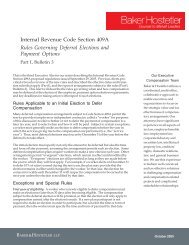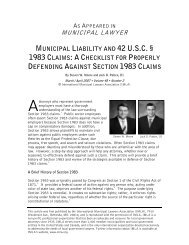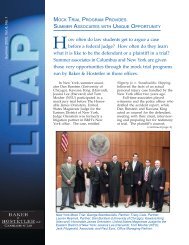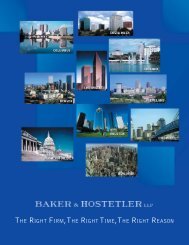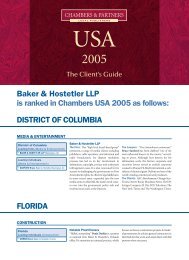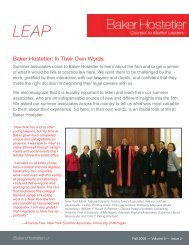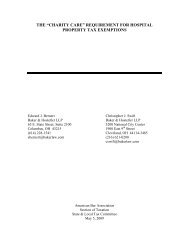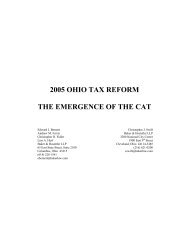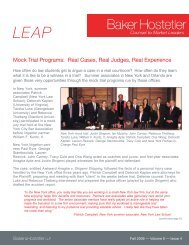Prejudgment Remedies in Texas - Doug D'Arche - Back to Main Page
Prejudgment Remedies in Texas - Doug D'Arche - Back to Main Page
Prejudgment Remedies in Texas - Doug D'Arche - Back to Main Page
- No tags were found...
Create successful ePaper yourself
Turn your PDF publications into a flip-book with our unique Google optimized e-Paper software.
James Talcott, Inc. v. Valley Federal Sav. & Loan Ass'n, 611 S.W.2d 692, 694 (Tex. Civ. App.—Corpus Christi 1980, no writ);N. Community property subject <strong>to</strong> the sole management by the non-deb<strong>to</strong>r spouse,if the underly<strong>in</strong>g claim arose before marriage or it is a vicarious liability aris<strong>in</strong>g dur<strong>in</strong>g marriage.Tex. Fam. Code § 3.202(b).O. Funds owned under a State Plan for Medical Assistance. 42 U.S.C.§1396a(a)(32).III.EXPLANATION OF THE SIGNIFICANT REMEDIES AVAILABLEA. GARNISHMENT1. OverviewGarnishment is a statu<strong>to</strong>ry proceed<strong>in</strong>g whereby the property, money or credits of aDeb<strong>to</strong>r <strong>in</strong> the possession of a third party are applied <strong>to</strong> the payment of the debt. Bank One v.Sunbelt Sav<strong>in</strong>gs, 824 S.W.2d 557, 558 (Tex. 1992); Lozano Assocs. v. La Experencia, 2008Tex. App. LEXIS 2696, *1 (Tex. App.—Dallas 2008, no pet.); Buckeye Ret. Co., LLC, v. Bank ofAm., N.A., 239 S.W.3d 394, 398 (Tex. App.—Dallas 2007, pet. denied). The third party thatholds the assets belong<strong>in</strong>g <strong>to</strong> the Deb<strong>to</strong>r is described as the "Garnishee." Once a Writ ofGarnishment has been served on a Garnishee, the Garnishee must freeze all funds and/orproperty held by the Garnishee at the time it is served with the Writ of Garnishment and anyfunds that are received through the date that the Garnishee files its answer. Tex. R. Civ. P. 661.Matter of Bohart, 743 F.2d 313, 324 (5 th Cir. 1984); Rome Industries, Inc. v. Intsel Southwest,683 S.W.2d 777, 779 (Tex. App.—Hous<strong>to</strong>n [14 th Dist.], 1984) writ ref'd n.r.e.). The maximumamount that should be frozen is set out <strong>in</strong> the Order grant<strong>in</strong>g the Writ of Garnishment. Tex. R.Civ. P. 658. The Garnishee is required <strong>to</strong> file a verified answer <strong>in</strong>dicat<strong>in</strong>g what, if anyth<strong>in</strong>g, it is<strong>in</strong>debted <strong>to</strong> the Deb<strong>to</strong>r at the time the answer was filed and what it was <strong>in</strong>debted when the writwas served. Tex. R. Civ. P. 661. Garnishment is a strictly statu<strong>to</strong>ry remedy and is governed byChapter 63 of the <strong>Texas</strong> Civil Practices and <strong>Remedies</strong> Code and Rules 657 - 679 of the <strong>Texas</strong>Rules of Civil Procedure. Because garnishment is an extraord<strong>in</strong>ary remedy, it will only besusta<strong>in</strong>ed if the proceed<strong>in</strong>gs are <strong>in</strong> strict conformity with the statu<strong>to</strong>ry requirements. Mendoza v.Luke Fruia Investments, 962 S.W.2d 650, 651 (Tex. App.—Corpus Christi 1998, no writ); CadleCo. v. Int’l Bank of Commerce, 2007 Tex. App. LEXIS 1952, *5-6 (Tex. App.—San An<strong>to</strong>nio2007, pet. denied). Although the Credi<strong>to</strong>r may recover at<strong>to</strong>rney’s fees <strong>in</strong>curred <strong>in</strong> collect<strong>in</strong>g theunderly<strong>in</strong>g debt, the Credi<strong>to</strong>r may not recover at<strong>to</strong>rney’s fees that are <strong>in</strong>curred <strong>in</strong> connectionwith the garnishment. Henry v. Ins. Co. of N. Am., 879 S.W.2d 366, 368-69 (Tex. App. —Hous<strong>to</strong>n [14th Dist.] 1994, no writ); Cadle Co., 2007 Tex. App. LEXIS 1952 at *14.2. The K<strong>in</strong>ds of Property that can be GarnishedA Writ of Garnishment reaches all the Deb<strong>to</strong>r's "effects" <strong>in</strong> the possession of theGarnishee. The term "effects" means all personal property and <strong>in</strong>terest there<strong>in</strong> other than thosethat are exempt from garnishment. TEX. R. CIV. P. 659, 661. After service of a Writ ofGarnishment, the Garnishee may not deliver any effects, or pay any debt, <strong>to</strong> the Deb<strong>to</strong>r. TEX.CIV. PRAC. & REM. CODE § 63.003.The types of effects that are usually garnished are funds or items of personal property.The personal property may <strong>in</strong>clude s<strong>to</strong>ck certificates, bonds, settlement proceeds, preciousmetals or any other non-exempt item. Funds may <strong>in</strong>clude those held <strong>in</strong> a bank account or anyother f<strong>in</strong>ancial <strong>in</strong>stitution. Garnishment is generally not appropriate for <strong>in</strong>tangible rights such as<strong>Page</strong> 4 of 36



